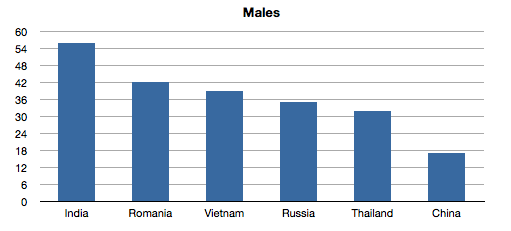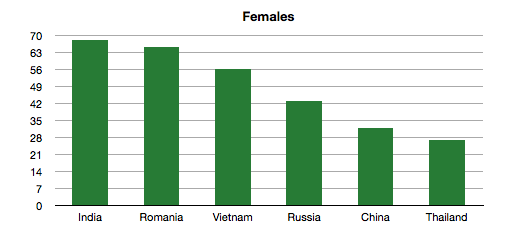Welcome Guest! To enable all features please Registers on the forum or Đăng ký.
Mình có đề này không biết nên bao gồm những thông tin nào, và các bước phân tích thế nào vậy mọi người.
Thanks.

In STEP 1 I can get something like this:
- There are 6 countries.
- Some bars are longer than others, there are significant differences in the proportion of proficient second language speakers among the different countries.
- There are two colours of bars – males and females are included in the study.
- The green lines are typically longer: generally more. females than males are proficient in a second language.
Romania, india, Vietnam are the 3 countries have the highest number of women study higher than men.
The number of women get higher education than men do is highest in Romania then in China, and lowest in Thailand.
Trong bar chart điều đầu tiên bạn nên nhớ là mỗi cột tượng trưng cho cái gì và xu hướng tăng hay giảm. Mình tách ra của MALES và FEMALES . Sau đó các bạn hãy so sánh những thay đổi giữa 2 giới nha.



Cuộc sống của bạn là của bạn và chính bạn chịu trách nhiệm cho chính cuộc đời mình chứ không phải tôi, bố mẹ hay bạn bè,…
Mình nghĩ là nên nói những ý này, mọi người tham khảo và đóng góp ý kiến nha.
FOR MALE:
1. India is much the largest (around 55%).
2. China is the smallest (about a third of India) (around 17%).
3. Romania, Vietnam, Russia and Thailand are in that order and approximately similar (between 32 and 42%).
FOR FEMALES:
1. India and Romania are the largest (around 65% and 65% respectively).
2. Thailand is the smallest (about 27%).
2. There are fairly significant differences between Vietnam, Russia and China.
Sửa bởi người viết
2013-07-09T16:14:56Z
|
Lý do: Chưa rõ
A wise man will make more opportunities than he finds.
Thanks a lot for your ideas. So great!
From the points, i can draw some conclusion. Every one please read and comment. Thanks a lot.
1. Typically, more females are proficient than males
2. Thailand is the exception because there the pattern is reversed (the lines cross)
3. Romanian females appear to be especially good at languages
I think that's enough for this topic.
Một phần quan trọng nữa là phải thể hiện sự những khác nhau giữa số lượng người học ngoại ngữ giữa các nước với nhau. Bằng cách nhìn vào chiều cao của mỗi cột trên hệ tọa độ. Để nhìn rõ những tỷ lệ này bạn có thể vẽ thành 1 pie chart như sau:
Sửa bởi người viết
2013-07-09T17:49:07Z
|
Lý do: Chưa rõ
Mình nói thế này được không?
1. China has significantly the lowest proportion of second language speakers.
2. India is much the largest.
3. There are no major differences between Romania, Russia, Thailand and Vietnam.
Mình có 1 kinh nghiệm chỗ này, mong mọi người đừng bị sai nữa, uổn lắm.
- Các bạn nhớ lúc làm phải xem lại cẩn thận các ý chính mình đã đưa ra khi phân tích đề ở bước 1 nha. Mình cứ mải mê viết, đến lúc nhìn lại thì không kịp thời gian sửa.
- Bước 2 khi sắp xếp: nhắc đến Males trước, sau đó so sánh với FEMALES vì biểu đồ của đề nhắc đến Males trước.
- Theo thứ tự giảm dần: nước có tỷ lệ cao nhất: the highest figure, sau đó đến các nước có tỷ lệ thấp hơn.
Bạn nào cho mình xin bài viết hoàn chỉnh cho đề trên với.
This bar chart shows how second language proficiency varies between males and females in 6 different countries. It is immediately apparent that while there is significant regional variation in second language ability, typically a higher percentage of females than males speak a second language well.
If we look at males we can see that India has much the greatest proportion of proficient second language speakers at around 55% and China has the least at fewer than 18%. There is only a 10% difference in competency ranging from around 40% to around 30% between Romania, Vietnam, Russia and Thailand in second to fourth places respectively. There are,however, notably more female than male second language speakers in every country with the exception of Thailand. So, India once again leads the way with around 65% , closely followed by Romania and then Vietnam and Russia at 56 and 42% in turn. The two countries with fewest proficient second language speakers are China and Thailand at around 30%. The final point to note is that of the countries in the report, India would appear to have the highest overall proportion of proficient second language speakers and China the least.
Di chuyển
- Bạn không thể tạo chủ đề mới trong diễn đàn này.
- Bạn không thể trả lời chủ đề trong diễn đàn này.
- Bạn không thể xóa bài của bạn trong diễn đàn này.
- Bạn không thể sửa bài của bạn trong diễn đàn này.
- Bạn không thể tạo bình chọn trong diễn đàn này.
- Bạn không thể bỏ phiếu bình chọn trong diễn đàn này.
Important Information:
The Trang chủ Diễn đàn chuyên IELTS uses cookies. By continuing to browse this site, you are agreeing to our use of cookies.
More Details
Close
